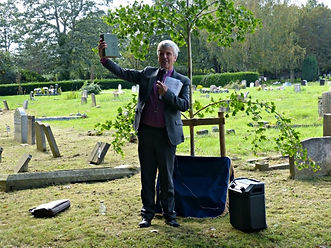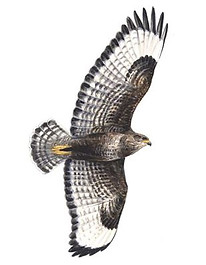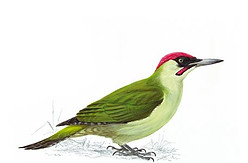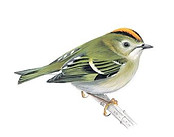Ecology
The cemetery covers an area of 12.27 hectares, and since 2005 has been designated as a Local Wildlife Site. Local Wildlife Sites are sites that are especially important and valuable for their wildlife. They are defined areas, identified and selected for their nature conservation value, based on important, distinctive and threatened habitats and species. The cemetery was given this status principally for its important population of grassland fungi, but its situation on a south-facing, gently sloping hillside makes it a haven for a wide variety of plants, insects, birds and mammals.


Due to the ongoing loss of unimproved grassland habitats there has been a decline in the numbers of certain species of waxcap and other grassland fungi. The cemetery is an important site for grassland fungi populations, in particular waxcaps; over 20 waxcap species have been recorded on the site. A fungi walk takes place in the cemetery every autumn: on the 2021 walk 68 fungi species were discovered.

The unimproved neutral to acid grassland covers soils based on Tunbridge Wells sands, and in the more open parts of the cemetery many typical meadow wild flowers can be seen, such as oxeye daisy (Leucanthemum vulgare), yarrow (Achillea millefolium), red clover (Trifolium pratense), bird’s foot trefoil (Lotus corniculatus), harebell (Campanula rotundifolia) and common sorrel (Rumex acetosa). These plants provide shelter and food for important pollinators including bees.
Harebell
Three species of orchid grow in the cemetery. The green-winged orchid (Anacamptis morio) is a short orchid of unimproved grasslands, growing mainly on chalky soils. It flowers in April or May; the flower spike carries a cluster of pinky-purple flowers (sometimes white) that give this orchid its name - the hood formed by the sepals is lined with green veins. Green-winged orchids are pollinated by bumblebees. The best place to see these orchids is in the Garden of Remembrance, where the grass cutting regime has been altered to encourage their spread.



Green winged orchid Autumn lady's-tresses Common spotted orchid
Autumn lady’s-tresses (Spiranthes spiralis) are delicate orchids whose individual white blooms grow in a near perfect spiral and are tightly packed against one another around the short stem. They flower from late August to late September. The leaves at the base die back before the flowers appear. Each flower has a green-centred lip with a frilly white edge. They are reported to have the scent of coconut. The best places to see these orchids are the Garden of Remembrance, and on the grass verges on either side of the main avenue.
Common spotted orchid
A single common spotted orchid (Dactylorhiza fuchsii) was found flowering in the cemetery for the first time in the summer of 2021. It is the most common of all UK orchids, and gets its name from its leaves, which are green with many purple, oval spots. They form a rosette at ground level before the flower spike appears; narrower leaves sheath the stem. The flowers range from white and pale pink, through to purple, but have distinctive darker pink spots and stripes on their three-lobed lips. The flowers are densely packed in short, cone-shaped clusters. It flowers in June and July.
Trees
There are more than 750 trees growing in the cemetery grounds, and over 70 different species. The oldest tree in the cemetery is an English yew tree (Taxus baccata), which stands just outside the working chapel and is estimated to have been planted in 1876, just three years after the cemetery opened. There are many Irish yew trees (Taxus baccata fastigiata) growing in the cemetery. These natural mutations can be easily distinguished from English yews because of their more compact, columnar shape.
English Yew Lawson cypress Irish Yew
Yew trees have long been associated with graveyards and burial grounds: it is thought that the druids believed they were symbolic of the regeneration of the natural world and the spirit. As a result, yew trees were often planted near temples or sacred places, and as these pagan temples were replaced by Christian churches the trees remained, with their evergreen foliage seen as symbolic of the resurrection. All parts of the tree are toxic to mammals, and it is possible that they were planted in large numbers in graveyards to deter commoners from grazing their animals on church land.
There are many mature conifers in the older parts of the cemetery, reflecting the fact that these trees were popular with the Victorians and Edwardians. Although they have currently fallen out of fashion, they are great for wildlife, providing cover and nesting places for birds, and harbouring many species of insect. There are more Lawson cypress trees (Chamaecyparis lawsoniana) in the cemetery than any other species. They are native to California and Oregon and are named after Scottish nurseryman Charles Lawson, who introduced many non-native plants to the United Kingdom. Close to the chapel are several magnificent mature Himalayan cedars (Cedrus deodara), and throughout the older part of the cemetery there are numerous massive Western red cedars (Thuja plicata), and some golden variants (Thuja plicata ‘Zebrina’).
In more recent times the borders of the main avenue towards the Bayham Road entrance have been planted with giant redwoods (Sequoiadendron giganteum). Planted in 1996, they are already large trees and could eventually reach a height of 50 meters.
Most of the more recently planted trees are deciduous, some of these providing beautiful blossoms in the spring and spectacular autumn colour. There are several Japanese cherry trees (Prunus serrulata) ‘Kanzan’, which have a display of showy pink double blossoms in April. Red maple (Acer rubrum), Norway maple (Acer platanoides) and Persian Ironwood (Parrotia persica) are all examples of trees in the cemetery which provide good autumn colour.
Japanese cherry tree London Planes
In the 1970s the verges of the main avenue leading down the hill from the twin chapels were planted with London Planes (Platanus acerifolia). These trees, which are a hybrid of the Oriental plane and the American sycamore, are particularly valued for their ability to adapt to urban conditions and their resistance to pollution. The trees cast a beautiful dappled shade, and for a large part of the year provide a pleasant green canopy over the avenue.
In the past few years four commemorative trees have been planted in the cemetery. In 2014 a winter flowering cherry (Prunus subhirtella autumnalis) was planted close to the grave of William Brentnall (1829 -1894), Tunbridge Wells Town Surveyor and designer of the cemetery, in 2020 a crab apple (Malus) ‘John Downie’ was planted in the Garden of Remembrance to commemorate the 75th anniversary of the end of the Second World War, and in September 2021 a maidenhair tree (Ginkgo biloba) was planted in memory of the many members of the China Inland Mission who are buried in the cemetery. Finally, in October 2021 a tree was planted as part of the Queen’s Green Canopy, a tree planting initiative to commemorate Her Majesty the Queen’s platinum jubilee in 2022. The tree chosen was a wild service tree (Sorbus torminalis).
Winter flowering cherry Crab apple ‘John Downie’ Dr. Janet Sturgis, Chair of the Friends, planting the wild service tree.
The Bishop of Guildford blessing the maidenhair tree
Wildlife
Recently roe deer (Capreolus capreolus) have begun to appear in the cemetery. Deer numbers have increased dramatically as result of a large reduction in the amount of culling taking place during the pandemic. New housing developments on greenfield sites near the cemetery causing the deer to lose their natural habitat may also be a contributory factor. Roe deer have bright red-brown fur in the summer, fading to a dull brown in the winter. Adult males have small antlers with up to three points which they shed and regrow each year. Both sexes have black noses, a white chin and white rump. Visitors to the cemetery have discovered that these beautiful animals have an unfortunate liking for flowers, with the result that many floral tributes left by grieving families have been destroyed.
Roe deer Badger damage to grave
The cemetery is home to at least one badger sett, although visitors to the cemetery are unlikely to ever see a badger as they are nocturnal. Badgers (Meles meles) are iconic countryside animals, with unmistakeable striped faces and powerful stocky bodies. Their preferred habitat is a mixture of woodland and open countryside. They live in family groups in underground setts, which can extend to 50 metres long. Their diet is mainly earthworms (they can eat hundreds in a single night), slugs and invertebrates.
Like the roe deer, having badgers in the cemetery is a mixed blessing; their underground excavations can cause memorials to subside or topple over, and the uneven ground around their setts can be hazardous for visitors to walk on.
A night bat walk took place in the cemetery in the summer of 2017, and two species of bat were identified as being resident, the soprano pipistrelle (Pipistrellus pygmaeus) and common pipistrelle (Pipistrellus pipistrellus). The two species are almost identical in appearance, with the soprano being slightly smaller. The common pipistrelle has a wingspan of around 20cm and weighs no more than a pound coin. Both species live on flies and other small insects, and their favoured habitat is parks, woodland and gardens. In the winter they hibernate in buildings, tree holes and bat boxes. Like badgers, bats are protected under UK Legislation.
Birds
The mix of tall mature trees, shrubs and open areas means that a wide variety of birds frequent the cemetery. No formal bird count has taken place, but finches, tits, blackbirds, sparrows and robins are often seen, and in the winter noisy flocks of starlings gather in the large conifers. Occasionally less common birds are spotted: green woodpeckers seem to favour the cemetery, feeding on ants and other insects on open grassy areas. Solitary song thrushes may be seen and heard singing from the tops of the tallest trees. On warm sunny days buzzards can be spotted soaring high in the sky over the cemetery, searching out their prey of small mammals, carrion and earthworms. The goldcrest, Europe’s smallest bird, favours coniferous woodland and parks with large trees, and is occasionally seen in the cemetery, hunting for insects in the conifers. Small noisy flocks of long-tailed tits have also been spotted in the winter, seeking out seeds.
Green Woodpecker Song Thrush
Buzzard
Long Tailed Tit Goldcrest
Images © RSPB


















